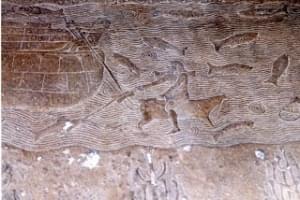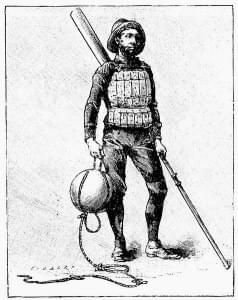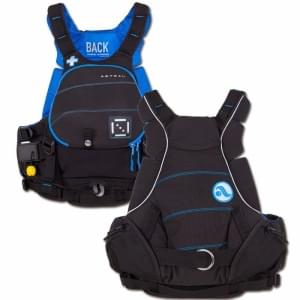The Problem Of Sinking: An Abbreviated History of the PFD
If you’ve ever been rafting, kayaking, or really any-thing on the river, then you’re—hopefully—familiar with PFDs, that is, Personal Flotation Devices, A.K.A., lifejackets, life preservers, Mae Wests, life vests, life savers, cork jackets, buoyancy aids or flotation suits.
(For those of you who may not be familiar with PFDs, they’re basically kind-of-puffy, vest-ish things filled with enough floaty stuff to help keep their wearers afloat when they wear them.)
Once you’ve spent enough time on, around, and especially in the river, you know not to take PFDs for granted. Well, you know not to take them for granted in the sense of always wearing one. But I’d be willing to bet that many, even most, of us who properly appreciate PFDs do take their existence in current form for granted.
So, in the interest of PFD Appreciation Day (a boater holiday I just invented; spread the word and mark your calendars), we present to you an abridged account of the historical evolution of the PFD. Enjoy.
As with so many things, the PFD’s origins seem to begin with goat skins.
 |
| Assyrian Tubers, with Mike Slagle |
Assyrian carvings dating back to between 865-860 BCE depict Assyrian enemies attempting to cross the Euphrates river while under attack of arrow using inflated goat skins—one arm around the inflated goat skin, and one moving water. Classic.
 |
| Erik Weiseth Pictured in Cork Vest |
The next link in the proverbial chain, equally lacking in solid evidentiary support, comes compliments of the Norwegians. These early seafarers and fjord-ers are credited with having utilized wood planks, empty barrels or rudimentary vests fashioned with or out of cork blocks as flotation aids. While wood planks and barrels are really more debris than dedicated flotation aid, the cork vests attributed to Norwegian innovation reflects a much more sophisticated approach to the problem of sinking as well the earliest functional analogue to the modern PFD.
After the Norwegian cork vest, PFD evolution eddies out for a while. In fact, the next notable jump in PFD development doesn’t come about until the advent of the iron ship (the first of which show up during the mid-19th century). Apparently, the iron ship was heavy enough, and left sparse (i.e., none) enough buoyant debris in catastrophes, to finally get people thinking seriously again about the problem of sinking.
Among the people starting to think about the problem of sinking was the good Mr. Guerrin:
“According to the United States Patent Office, Napoleon Edouard Guerin of New York City, New York was issued a patent for ‘Improvement in Buoyant Dresses or Life-Preservers’ on November 16, 1841. Mr. Guerin’s design was for a jacket, waistcoat, or coat made of cotton or other material (double layered) that could receive eighteen to twenty quarts of rasped or grated cork (a profile of the rasp was even included in the patent drawings).”[2]
Around this same time, during the early years of the iron ship, the first acknowledged incarnation of the modern lifejacket appears. Its 1854 advent is credited to a Captain Ward, who was an inspector with the Royal National Lifeboat Institution. Like its Norwegian predecessors, Ward’s vest also relied on cork flotation. As such, the only obvious reason for Ward’s vest being accorded the titular honor of first modern lifejacket seems to be that its purpose was explicitly defined as being for “weather protection and buoyancy.” Beyond that stated intent, it differs little from its Norwegian ancestors and did little to advance PFD evolution.
What did advance PFD evolution, though, was America (“USA! USA!”). In 1902, the U.S. introduced Kapok as an alternative buoyant material to cork. Upon reflection, this was the most substantial (no pun intended) progress made in PFD technology since the transition from barrel to cork (despite Kapok’s later-discovered flammability and lack of durability under compression). Contemporaneous with the rise of Kapok and other alternative buoyant materials (like Balsa wood), and to some extent attributable to processes of technological innovation & diffusion associated with WWI and WWII, this period also saw the development and increasing refinement of inflatable floatation devices.
One inflatable floatation device gained particular renown: the B-4 Life Preserver. The B-4 Life Preserver, nicknamed the “Mae West” after the buxom actress popular at the time, hit the scene in 1940 and much used by U.S. and Allied troops during the Second World War. Its advent is alternatively credited to James F. Boyle, Andrew Toti or Andrew Markus, depending whom you ask or where you look. Unlike its predecessors, the Mae West was made of cotton, with sheaths containing inflatable air bladders, which were inflated either by co2 cartridge or by mouth.
 |
| The Astral Green Vest |
After the Mae West, PFD technology accelerates dramatically, especially during the 1960s and 1970s, quickly arriving at recognizable forms of the modern PFD.
Key innovations of the period include, but are by no means limited to: petroleum-based synthetic foams, which are lighter, more buoyant and malleable than were previous materials; self-righting floatation, an important development for obvious reasons, and; things like adjustable straps, which allow for cinching your modern Goat-bag to you.
The lessons of this abbreviated history are these:
- Cork was king, then Kapok, now foam.
- The lives of people or groups of people who spent their days on the water were not highly valued for most of human history.
- Lots of people died because PFDs were not an option.
- Not wearing your PFD in situations that call for it is ungrateful. Also, it’s stupid.
- Dead Goats are good for more than just eating.
